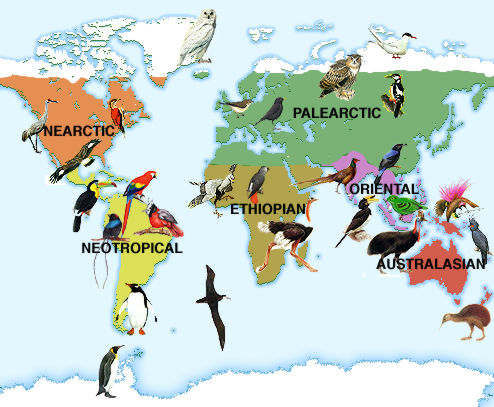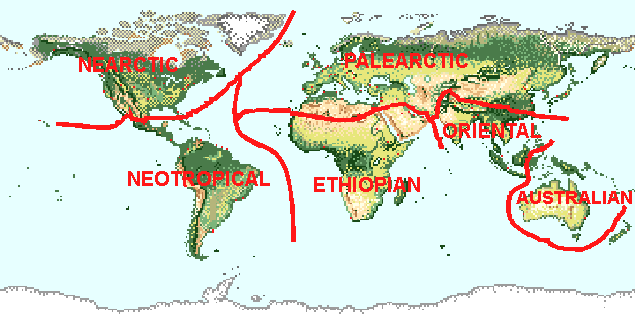|
|
 ----
----
-
-

-
| Zoogeographic provinces
are regions of distinctive fauna. They are based on the taxonomic or phylogenetic
relationships of animals and not the adaptations of animals to specific
environments. One way of looking at this is to think of the fauna of each
province as constituting the gene pool available to the forces of natural
selection to adapt animal life to the variety of habitats present in the
particular region. The gene pool (i.e, the taxa represented) is different
in each province.
Following the concept of a region as used in geography, each province maintains a level of homogeniety within its borders and clearly differs from adjacent areas. The boundaries between zoogeographic provinces are drawn according to the distribution of vertebrate taxa (in particular, families). Sclater, who is commonly acknowledged as the developer of this system of drawing regions according to fauna, based his regions on the taxonomic relationships of birds; but the same regional limits work well enough for fishes, amphibians, reptiles, and mammals. The data used to delineate regions were compiled
long before continental drift was even considered. Furthermore, they represent
only taxa extant in the 19th century. Paleontological advances, particularly
in the 20th century, have added new information on the distribution of
vertebrate families that negate some of the assumptions of Slater, Wallace
and others.
The exact locations of boundaries of any region are often problematic, and this is certainly true for zoogeographic provinces. The boundary between the Oriental and Australian provinces, for example, has been redrawn several times; the most famous version is known as Wallace's Line, which falls between Borneo and Sulawesi and between the tiny islands of Bali and Lombok. The latter pair of islands are separated by a mere 20 miles, but for the most part they are inhabited by different families of mammals and even birds with all the powers of flight..
|
Wallace's Line
Alfred Russel Wallace, the so-called father of animal geography, formulated his ideas on evolution by natural selection while observing and collecting wildlife in the islands of Southeast Asia. He was particularly impressed by the sudden difference in bird families he encountered when he sailed some twenty miles east of the island of Bali and landed on Lombok. On Bali the birds were clearly related to those of the larger islands of Java and Sumatra and mainland Malaysia. On Lombok the birds were clearly related to those of New Guinea and Australia. He marked the channel between Bali and Lombok as the divide between two great zoogeographic regions, the Oriental and Australian. In his honor this dividing line, which extends northward between Borneo and Sulawesi, is still referred to today as Wallace's Line. (See the map)
Other biogeographers have since put the boundary between the Oriental and Australian provinces in slightly different locations. As is true of most regions, the core areas of both provinces are clearly distinct, but things are a little fuzzy on the periphery. Thus some biogeographers recognize the island region between Java and New Guinea as a mixing zone and designate it Wallacea.Links: